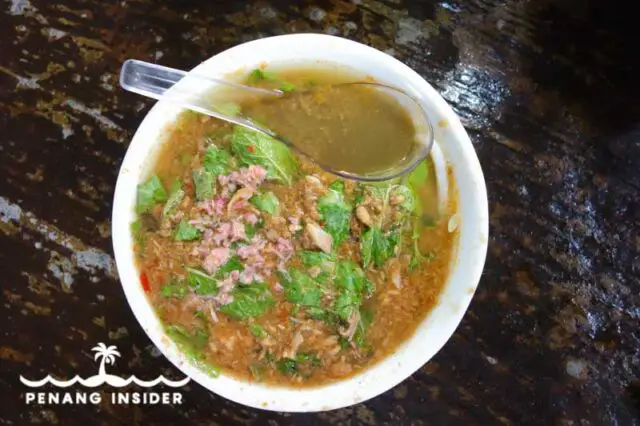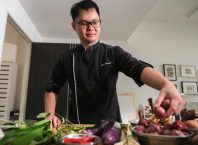Tangy, fish-scented, heavenly broth served with a web of thick and juicy noodles: together with Nasi Kandar, Penang Laksa may be one of the most characteristic and authentic foods in Penang — don’t know where to get started on your food hunt? Check out our list of 26 must-try Penang foods you cannot miss and our guides to breakfast in Penang and Penang’s best cafes — and if you have wheels, make the one hour drive to Taiping for more great food.
Keep in mind that there are many places to try Penang Laksa, both in George Town and all around the island. Also, do you want to try Asam Laksa Penang, or Laksa Siam? As there’s quite a bit of choice available, we have decided to write this article to help you hunt down the “perfect Penang Laksa” (if even such a thing exists).
To make the selection the best we could we resorted to the help of a local Penang Laksa superstar: we are referring to the one and only Nazlina Hussin, or the “fierce Penang aunty” who not only runs the excellent cooking class Nazlina Spice Station but also wrote one full book dedicated to the best Laksa. You can buy “The Fierce Aunty’s No-Nonsense Guide to the Perfect Laksa” in Penang at Areca Books, Gerakbudaya Bookstore, MPH, and shops at attraction sites such as the Habitat, E&O Hotel, Peranakan Mansion, and Tropical Spice Garden.
And since few people know about Penang Laksa better than Nazlina, that’s why we are giving her the lead right now.
The Best Penang Laksa as Suggested by Chef and Writer Nazlina Hussin
Since I wrote my Penang Laksa book I was regarded as “the Laksa Queen”. Too much honor given, because I simply shared what I knew in that book, and tried to be as detailed as possible. Since then, too many people have asked me for recommendations on where to eat the best laksa in Penang — I will try my best to give you my most honest, current reviews and opinions in this article.

Deciding what is the best Penang Laksa is actually a daunting task, as individual tastes vary, and the fleeting, ever-changing nature of the laksa gravy makes it hard to maintain the same standard each and every time. Laksa gravy thickens when it is being slowly boiled for hours, and it can burn and dries out if you’re not careful. On top of that, Penang cooks are known to add in water, salt, and tamarind accordingly to adjust the taste and make it more acceptable. For the reasons above, the same eatery can cook up very nice, thin, too thick, too sour, good, and bad Laksa.
In general, Penang Laksa is served by humble little hawkers’ carts on the street, Pasar Malam — which means “night market” in Malay… read our article on the best night markets in Penang — or at food courts. However, some upmarket restaurants do serve Laksa as popular comfort food and you can also choose it from their menus.
This post lists 8 Penang laksa joints that I, Nazlina Hussin, tried over the last 4 weeks during the “semi-lockdown” period as Malaysia’s economy was slowly recovering from the threat of COVID–19.
Famous Penang Asam Laksa in Balik Pulau
There are three institutions that are regarded as the popular laksa spots not to be missed when one comes to visit Balik Pulau. As Nazlina lives in Balik Pulau, we will start from there. Don’t forget to check out our Penang street art guide to know the beautiful murals of Balik Pulau.
1Kim Seng Kopitiam
The current location for this coffee shop is at a strip mall at Botanica City. They sell other street food like char koay teow but this coffee shop is more famous for its laksa. Food was available strictly for take-aways at that time of my research, so I bought both types of laksa dishes that they offer: Penang Asam laksa and laksa lemak. Both were priced at RM5 (about US $1.2). I brought my own containers, packed the two types of laksa, and went home to savor them one by one.
What I like most about Kim Seng’s laksa is the generous amount of vegetables lavished on top of the bowl. They were truly fresh and plenty. The asam laksa had a fragrance of sweet potatoes which I truly enjoyed — sweet potatoes are invariably added to thicken up the laksa gravy, and please note that I am not using the word “soup” to describe the liquid that comes with the laksa.
Kim Seng’s laksa lemak was really the best I have tasted in Penang for the cheap price of RM5! It was fragrant, thick and full of flavour. One certainly doesn’t need to add hae ko (“petis”/liquid prawn paste) to make it more palatable. So, both thumbs up for me, especially for Kim Seng’s lemak laksa.
2Kim Laksa

Kim laksa, inside the Nan Guang Kopitiam, is an institution in Balik Pulau, having been located at a very strategic place: a former wet market at the heart of Balik Pulau’s Pekan Kongsi (read our guide to the best things to do in Balik Pulau). Now, the wet market is replaced by a car park, but Kim Laksa still is a popular choice. I went there and ordered both asam laksa and laksa lemak (which initially was ordered as a takeaway). I have eaten there several times, usually not by choice, but because I had visitors and I took them around to savor local fares.
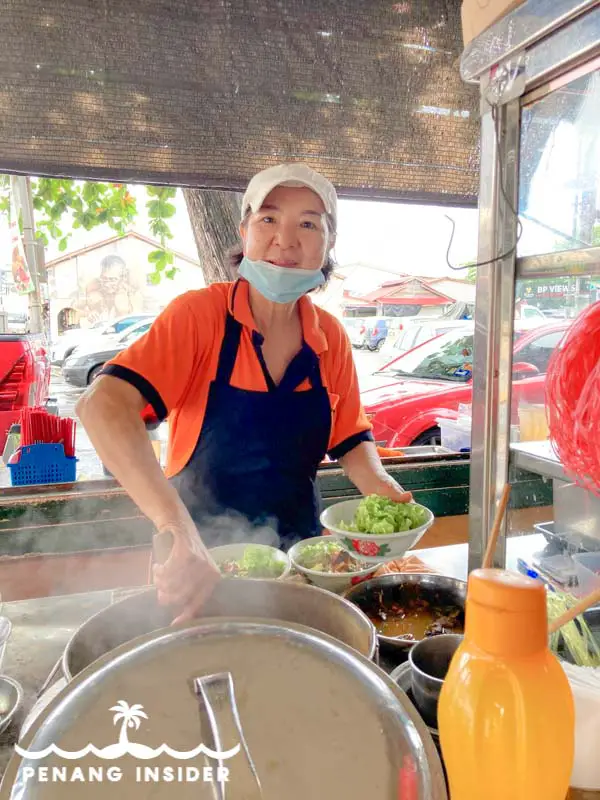
To be honest, the gravy for both laksa bowls was nothing to shout about: to me, it was too watery and I had to add the prawn paste to get more flavor. The noodles were also broken up, and the portion was small for the dining in — but surprisingly I got more noodles in my takeaway pack that I initially intended to consume at home. I knew that because I poured the noodles into the same bowl at the shop and they filled it up much more than the ones I got for dining in.
The price was RM5 (about US $ 1.2) for each bowl and, it is customary to eat laksa there drinking fresh nutmeg juice or a Calamansi lime drink with preserved Chinese plums.
3Laksa Janggus
This Malay laksa shop is located at a Malay village in the Pulau Betong area of Balik Pulau, and not too far from the Audi Guest House — if you like cycling, it’s a great place to go in Penang with kids. Laksa Janggus became famous after TV3’s show Jalan-Jalan Cari Makan featured it in its show. It is opened daily except for Wednesdays. Despite its location away from the city center, even from Balik Pulau’s Kongsi, people throng here to eat, especially on weekends. I bought a packet to take home, and it cost me only RM3.50 (about US $ 0.90). A very fair price. It tasted like the laksa that I can get from any Pasar Malam: acceptable, but in my humble opinion, it does not really deserve its media fame. Please DO not shoot me, this is just my personal opinion.
4 Kedai Kopi Ko Cha Bi
The first time I had asam laksa from this coffee shop was in 2010. I was not impressed because it was too acidic and I had a really bad stomach ache afterward. I never set foot there again until October 2020 when I needed to repair my punctured bicycle tires and I had twenty minutes to kill.
It was blistering hot in Balik Pulau, and some cool respite could be only found in those narrow tiny shops of the Old Town. So I thought, why not have a bowl of laksa?
Ko Cha Bi was in the same row. Due to COVID-19 pandemic regulations, the shop had been scrubbed up and looked uncluttered and more welcoming than the previous time I was there. I opted for asam laksa, which was presented inside a bowl, topped up with shredded boiled sardine.
It was the first time I ever saw a laksa bowl served up this way. Usually, if there’s any boiled sardine on top, it would be fillet, rather than shredded fish flesh. I loved the soup: the sourness was right, the spice level high. And I loved the noodles’ texture, too. I’d probably go there again for the noodles alone!
The overall experience was pleasant, and when I went back to the bicycle shop, I even found out that my bike had been repaired timely during my meal.
The Most Famous Penang Asam Laksa?
5Laksa Air Itam

This might be the most well-known laksa in Penang, having dished up the heavenly broth since no less than 1955, and firmly set on the tourist trail in the market at the bottom of the famous Kek Lok Si Temple. The first time I ate at this laksa stall was in 2008, and believe it or not, I haven’t come back to visit until Malaysia’s Movement Control Order was relaxed a couple of months ago. I went to Laksa Air Itam by myself on a hot afternoon and ordered one bowl of laksa and one drink. I sat at the round metal table and perched on the round metal stool to be transported back to my first time… the taste of Laksa Air Itam is still delicious.
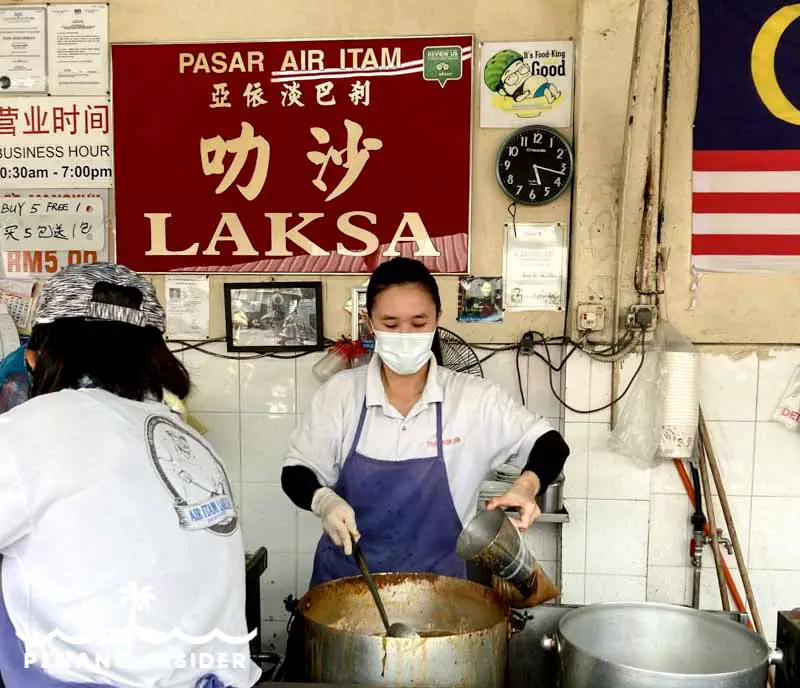
At RM5.00 (US $ 1.2) it just hit the spot perfectly. My nose watered because it was spicy, but in a good way, and no extra shrimp paste was required to enhance the flavor. It really was THAT good. The place now has its own Facebook page where you can get information on its location and opening times, check it out here. Yes, we still agree that if there must be ONE place for Penang Asam Laksa, this IS IT!
6Laksa Mamu
The smell of laksa gravy wafting from Mamu’s Laksa stall reminded me of my childhood. It was the smell of a charcoal burner, heating up a big Indian aluminum vat at Jual Murah (Penang Bazaar). Boy, despite the blunt knife I was given to cut the boiled egg, the onion, cucumber and mint used as garnish made for the ultimate comfort food. Please people, do not desecrate this special laksa gravy by adding in hae ko, as you really don’t need it. This stall, located outside Top Maple at Jalan Sungai Pinang, shares the shade with a mee rebus-mee goreng seller. I love the homemade noodles too, they are different from Chinese laksa rice noodles, not as juicy, but more ricey and starchy.
7Laksa Sotong

This Malay laksa cart is located just outside the floating mosque at Tanjung Bungah. Basically, it is an asam laksa, but you have an option to add in sambal sotong (cuttlefish in sambal) as an add on. A bowl fully garnished with squid costs RM 6.50 (about US $1.5), while a simple laksa is just RM 4.00 ( about US $1). The gravy reminded me of the laksa you can find in the Malaysian states of Kedah and Perlis, with that peculiar taste I associate with the laksa you can find at Malay Pasar Malam, with an additional boiled egg. I enjoyed it, and no prawn paste was required to enhance the flavor.
8D’ Laksa (AEON)
When you enter the food court at AEON anywhere in Malaysia, the smell of laksa assaults your senses. D’Laksa is located at the basement of Queensbay Mall, at AEON’s Supermarket. It is supposed to based on a Malay recipe but it also has Chinese influence, it tasted like Asam Pedas Melaka with chunks of mackerels. The gravy was very fishy such that any additional petis/otak udang/hei ko would be redundant. It was super spicy. The garnish was sparing, and not very fresh at the time of my meal. It was also very, very acidic. I loved it but would not eat it often because of the generous amount of tamarind and chilies in the spice paste. You can opt for extra fish balls – an influence from the Chinese. Only a few laksa stalls nationwide that I can see, add fish balls in asam laksa. RM 9.90 (about US $2.2) for a ‘big’ bowl.
9Penang Road Famous Teochew Chendul
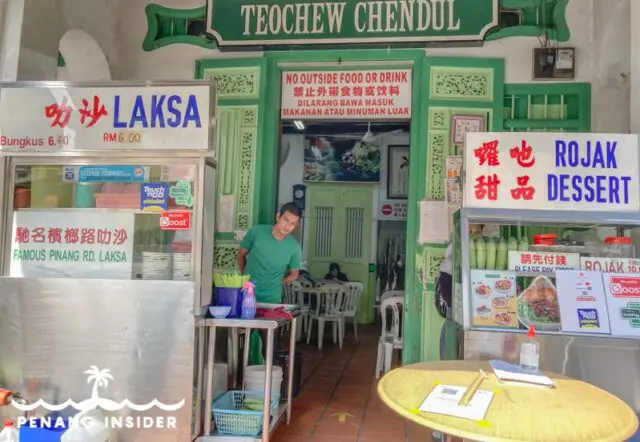
Penang Road Famous Teochew Chendul was established in 1936 at Lorong Keng Kwee off Penang Road, just selling chendul. Over the years, they added other items on their menu, including Penang asam laksa, and also started to franchise the business nationwide. The last time I ate at the original spot was sometime in December 2019, and it was a disappointment. The gravy, scratch that, “soup” was burnt and I could smell it. It was even more embarrassing as I took Samantha from Bangkok Foodies to taste it on that day. I believe that this famous stall is the reason why laksa gravy is referred to as a “fish
soup” by many food bloggers: it is really runny and of course smells very fishy… I suspect they put in hae koh into their gravy, so that you don’t have to ask for it as an extra topping.
I tried the laksa at Penang Road Famous Teochew Chendul again hoping for a better outcome. It was slightly better, but being old school, I cannot help but nitpick. They used a vegetable spiralizer to cut the cucumber for the garnish, and in my book, it was wrong. Very wrong, for the texture is just not right. Being famous carries a lot of responsibility, and I believe that this outlet does not carry itself proudly anymore because everything that I tasted today was dismal. The laksa, the rojak, and the chendul: to give you an example, the chendul’s coconut milk and palm sugar were so watered down!
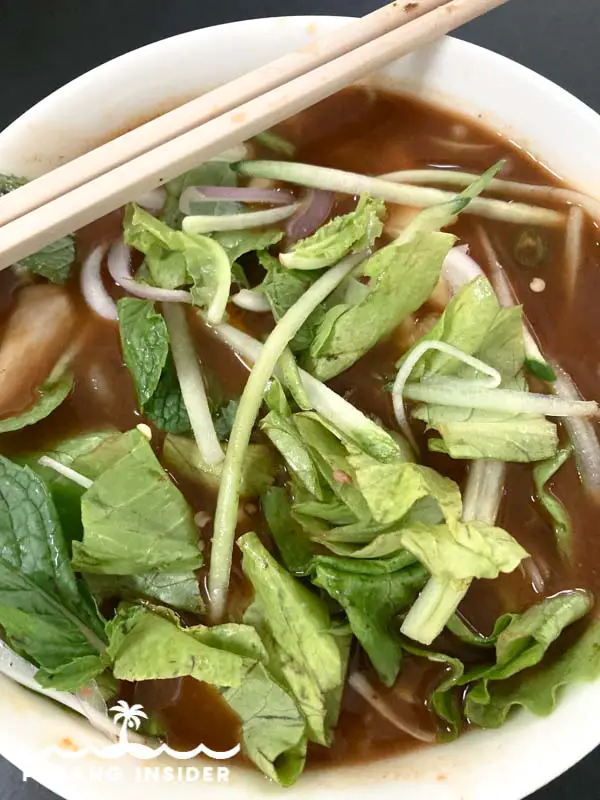
Besides being very fishy, the Laksa soup was spicy and very sour but that was about it… nothing to shout “famous” about. There was no aroma coming from either the ginger flower or the Vietnamese mint… just a plain fishy, smelly, sour and sharp spicy flavor. The only thing I liked was the smooth texture of the noodles, but even then, they were mostly broken. One Asam Laksa bowl costs RM6.00, which is one ringgit more than your average hawker laksa. Look, I don’t mind paying more for a better quality bowl of laksa, because I know well how much work is involved in making it. However, it needs justification. What I am trying to say is that, even by doubling the price, customers would not balk to fork out the amount if they come out smiling and satisfied with the meal. But, that is another discussion that we can carry out at another time.
10Relau 88 Laksa 妈妈味
By Marco Ferrarese
So I have been hearing about this “hidden gem of Penang laksa” for a while. Tucked up a right turn along the main road that connects Air Hitam and Relau, Relau 88 Laksa is housed inside a non-descript shop covered in potted plants that looks like a greenhouse. The description sounded pretty mysterious and alluring, something quite fitting for a real Penang hidden secret.
I decided to go and check it out on a Sunday and drove from George Town especially to try the laksa. What to say… Relau 88 Laksa is simple but cozy, and really not the “hidden spot” you would expect anymore. The self-described “authentic Penangite” auntie here has a crew of foreign workers as helpers, a nice set up of stone tables under metallic roofing, and quite a number of customers.
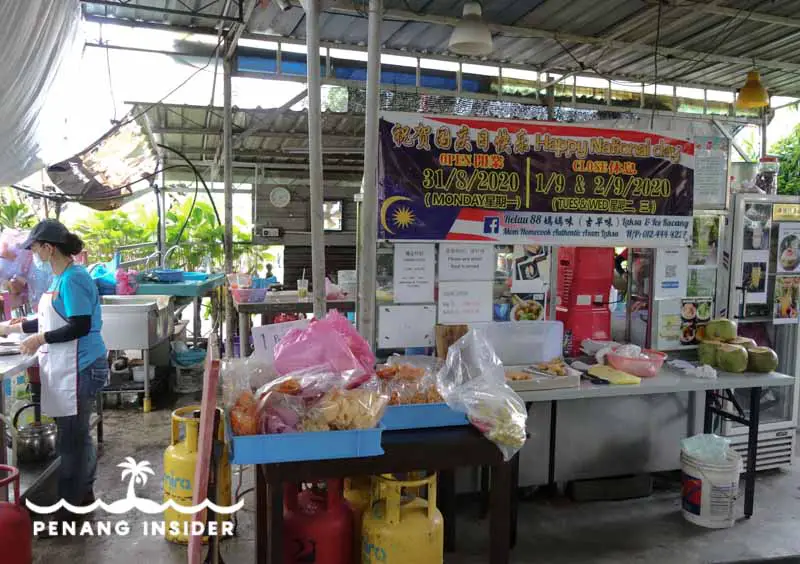
This said, Relau 88 remains a traditional stall, and beyond the bowls of Asam Laksa, one can order other nibbles like fried popiah, different types of keropok, and other Chinese-style fritters. The laksa, as expected from somewhere kind-of-popular, is asam style and is pretty good. I got a small bowl for RM4.5 and I can say that the taste was tangy, rich in texture, and definitely what I expected from a respectable asam laksa. To be very honest though, I was disappointed with the very stingy portion of noodles: I understand, I asked for a small bowl, but that didn’t mean I asked for asam broth only. Where did youput my laksa noodles, auntie? Apart from this little spoiler, I enjoyed my meal and would definitely recommend stopping at Relau 88 Laksa — but I would not drive all the way down here from George Town again when a better laksa is served at the Air Hitam market, which is much closer to my home.
What I loved the most about Relau 88 though was not the laksa, but their ais kacang and cendol. The cendol was delicious, served with loads of gula Melaka, coconut milk, and beans that were very well cooked. The cendol strips however looked like they had been frozen, so it wasn’t absolutely perfect — still definitely worth trying.

The ais kacang has a rosy scent and the shaved ice had a nice texture. In brief, if you find yourself in the south of the island, you should definitely come around Relau 88 for the laksa. Leave with no disappointment by topping up your meal with a dessert of your choice. Remember that the place is open from 12.30 to 5.30 pm and closed on Mondays.







